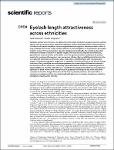Eyelash length attractiveness across ethnicities
| dc.contributor.author | Pazhoohi, F | |
| dc.contributor.author | Kingstone, A | |
| dc.date.accessioned | 2023-11-27T17:33:48Z | |
| dc.date.available | 2023-11-27T17:33:48Z | |
| dc.date.issued | 2023-09-08 | |
| dc.identifier.issn | 2045-2322 | |
| dc.identifier.issn | 2045-2322 | |
| dc.identifier.other | 14849 | |
| dc.identifier.uri | https://pearl.plymouth.ac.uk/handle/10026.1/21708 | |
| dc.description.abstract |
Eyelashes evolved to protect eyes. An optimum eyelash length functions to protect eyes from external hazards such as contaminations, excessive evaporation or shear stress from airflow. They can also be an indicator of a person's health as various congenital and noncongenital diseases can lead to short or long eyelashes. The current study aimed to extend a recent investigation on the preference for eyelash length in humans from an evolutionary adaptive perspective. Specifically, the current study tested whether the inverted-U function for eyelash length preference recently reported for White faces, generalises to other ethnicities, and whether ethnic background modulates preference for eyelash lengths. To investigate this question, men and women of Asian, Black, and White ethnicities from the U.S. rated the attractiveness of female Indian, Asian, Black, and White faces with varying eyelash lengths. The eyelashes ranged in length from no eyelashes to half the width of an eye. Results showed that Asian, Black, and White men and women preference for eyelash length followed an inverted-U function across all four ethnicities, supporting a general preference for human eyelash length that is approximately one-third the width of an eye. In addition, the results showed that the most attractive eyelashes for Black women were skewed toward a greater eyelash-length to eye-width ratio when compared to the other images. The source of this skew is presently unknown, as it could reflect a change in perceptual sensitivity to eyelash length with skin colour or changes in preference related to perceptions of participants’ ethnicity. | |
| dc.format.extent | 14849- | |
| dc.format.medium | Electronic | |
| dc.language | en | |
| dc.publisher | Springer Science and Business Media LLC | |
| dc.subject | Female | |
| dc.subject | Humans | |
| dc.subject | Male | |
| dc.subject | Asian | |
| dc.subject | Biological Evolution | |
| dc.subject | Ethnicity | |
| dc.subject | Eyelashes | |
| dc.subject | Beauty | |
| dc.subject | White | |
| dc.subject | Black or African American | |
| dc.title | Eyelash length attractiveness across ethnicities | |
| dc.type | journal-article | |
| dc.type | Journal Article | |
| plymouth.author-url | https://www.ncbi.nlm.nih.gov/pubmed/37684317 | |
| plymouth.issue | 1 | |
| plymouth.volume | 13 | |
| plymouth.publisher-url | http://dx.doi.org/10.1038/s41598-023-41739-5 | |
| plymouth.publication-status | Published online | |
| plymouth.journal | Scientific Reports | |
| dc.identifier.doi | 10.1038/s41598-023-41739-5 | |
| plymouth.organisational-group | |Plymouth | |
| plymouth.organisational-group | |Plymouth|Faculty of Health | |
| plymouth.organisational-group | |Plymouth|Faculty of Health|School of Psychology | |
| plymouth.organisational-group | |Plymouth|Users by role | |
| plymouth.organisational-group | |Plymouth|Users by role|Academics | |
| dc.publisher.place | England | |
| dcterms.dateAccepted | 2023-08-30 | |
| dc.date.updated | 2023-11-27T17:33:47Z | |
| dc.rights.embargodate | 2023-11-28 | |
| dc.identifier.eissn | 2045-2322 | |
| rioxxterms.versionofrecord | 10.1038/s41598-023-41739-5 |


